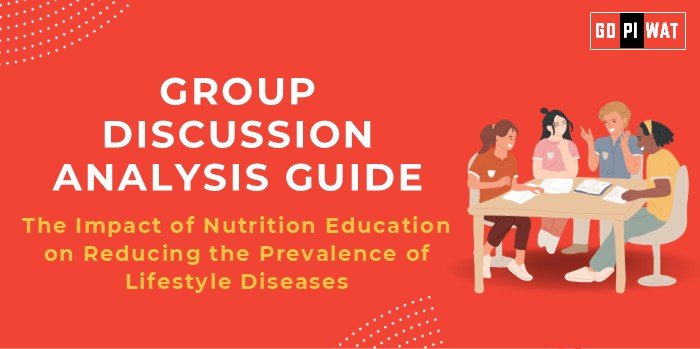📋 Group Discussion (GD) Analysis Guide
🌟 Topic: The Impact of Nutrition Education on Reducing the Prevalence of Lifestyle Diseases
🌐 Introduction to the Topic
Opening Context: Globally, lifestyle diseases like diabetes, obesity, and heart conditions are the leading causes of morbidity and mortality. Poor nutrition habits are among the primary contributors. Nutrition education serves as a powerful tool to combat this growing epidemic by equipping individuals with the knowledge to make healthier dietary choices. For B-school students, this topic bridges public health with management strategies in healthcare systems.
Topic Background: Lifestyle diseases have surged due to urbanization, sedentary lifestyles, and poor diet choices. Initiatives such as school-based nutrition programs and awareness campaigns have emerged globally. In India, programs like POSHAN Abhiyaan aim to tackle malnutrition, with increasing emphasis on preventive healthcare.
📊 Quick Facts and Key Statistics
- 🌍 Global Obesity Prevalence: Over 1 billion people obese (WHO, 2023) – Highlights the scale of the issue.
- 🇮🇳 Lifestyle Diseases in India: Account for 60% of deaths (ICMR, 2023).
- 📚 Nutrition Knowledge Gap: 70% of adults unaware of daily caloric needs (Global Nutrition Report, 2023).
- 💸 Economic Impact: India loses $12 billion annually due to productivity loss linked to lifestyle diseases (World Bank, 2022).
🤝 Stakeholders and Their Roles
- Government Agencies: Implement public health campaigns and policies (e.g., FSSAI’s Eat Right India).
- Healthcare Providers: Offer preventive care and nutritional counseling.
- Educational Institutions: Integrate nutrition education into curriculums.
- Private Sector: Develop innovative nutritional products and support wellness programs.
- Citizens: Adopt and practice healthy eating habits.
🏆 Achievements and Challenges
🎯 Achievements
- School Nutrition Programs: States like Tamil Nadu report reduced child obesity rates.
- Policy Successes: POSHAN Abhiyaan has improved nutritional outcomes for 70 million women and children.
- Global Example: Finland reduced heart disease rates by 75% through national dietary interventions.
⚠️ Challenges
- Awareness Gaps: Limited outreach in rural areas.
- Cultural Barriers: Resistance to dietary changes due to traditional eating habits.
- Economic Constraints: High cost of nutritious foods limits access for low-income groups.
🌍 Global Comparisons
- United States: The Healthy, Hunger-Free Kids Act led to a 13% reduction in child obesity.
- Japan: Nutrition education in schools contributed to one of the world’s lowest obesity rates.
📄 Structured Arguments for Discussion
- Supporting Stance: “Nutrition education empowers individuals to prevent lifestyle diseases, reducing healthcare costs significantly.”
- Opposing Stance: “Without addressing affordability and accessibility, nutrition education alone cannot curb lifestyle diseases.”
- Balanced Perspective: “While essential, nutrition education needs to be supported by policy interventions and economic reforms.”
✨ Effective Discussion Approaches
- Opening Approaches:
- Statistical Impact: “Lifestyle diseases account for 60% of deaths in India; nutrition education is key to reversing this trend.”
- Case Study Opening: “Finland’s dietary interventions show the power of nutrition education in reducing heart disease by 75%.”
- Counter-Argument Handling:
- Acknowledge affordability concerns but emphasize success stories like Japan’s school-based programs.
📊 Strategic Analysis of Strengths and Weaknesses
- Strengths: Preventive focus, cost-effectiveness, community engagement potential.
- Weaknesses: Cultural resistance, limited resources, low penetration in rural areas.
- Opportunities: Integration with technology, partnerships with food industry players.
- Threats: Misinformation, resistance from junk food industry.
🔗 Connecting with B-School Applications
- Real-World Applications: Develop business models for affordable nutritional products.
- Sample Interview Questions:
- “What role can nutrition education play in reducing healthcare costs?”
- “How can technology enhance the reach of nutrition education programs?”
- Insights for Students: Explore market opportunities for wellness products; analyze public health campaigns.


